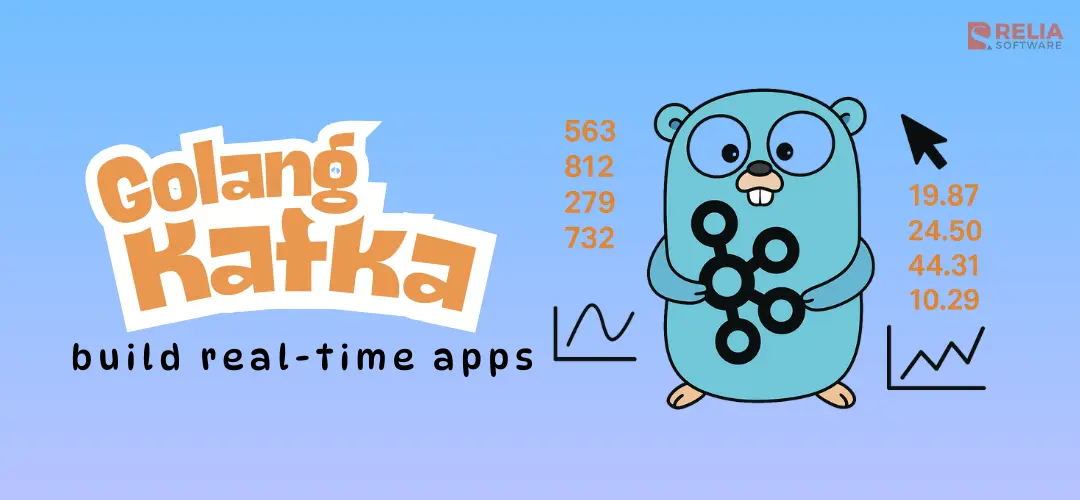Apache Kafka and Golang work together to create powerful real-time applications that can handle massive amounts of data instantly. Think of Kafka as a super-efficient messaging system that never loses messages, and Golang as the perfect programming language to build fast, reliable applications. This guide will show you how to combine these technologies to finish a strong real-time Go app.
>> Read more: Implementing Pub/Sub in Go with Redis for Real-Time Apps
What Is Kafka?
Apache Kafka is a system built to handle massive amounts of data in motion. It lets applications send, receive, and process streams of information in real time. Companies use Kafka to process everything from website clicks to financial transactions as they happen.
The Core Components of Kafka:
- Brokers serve as the storage units that keep your data safe and organized across multiple servers. Think of them as warehouses that store messages until applications are ready to process them.
- Topics represent different categories of information, similar to filing cabinets with specific labels. For example, you might have separate topics for "customer orders," "payment transactions," and "inventory updates."
- Producers are applications that send data into Kafka topics. They're like workers who deposit mail into the correct mailboxes.
- Consumers are applications that read data from Kafka topics. They function like mail carriers who collect and deliver messages to their final destinations.
- Consumer Groups allow multiple applications to work together to process large amounts of data more efficiently. This is similar to having a team of mail carriers instead of just one person handling all deliveries.
3 Common Golang Libraries for Kafka
The Go programming ecosystem offers three mature libraries for working with Kafka, each with distinct advantages:
- Confluent-kafka-go provides the most comprehensive feature set and comes with extensive documentation. This library wraps around a battle-tested C library, making it extremely reliable for production use. Choose this option when you need maximum features and don't mind slightly more complex setup.
- Sarama offers a pure Go implementation that's been widely adopted by the community. This library provides essential Kafka functionality with simpler configuration. It's an excellent choice for teams that prefer Go-native solutions and want to avoid external dependencies.
- Segmentio/kafka-go delivers both simple and advanced interfaces while following Go's standard library patterns. This library often performs faster than alternatives because it doesn't rely on external C libraries. Select this option when performance is your primary concern.
When choosing between libraries, consider your specific use case. Most performance tests show Confluent-kafka-go performing better in 9 out of 10 scenarios, except when dealing with very small messages (around 200 bytes). However, kafka-go consistently delivers higher throughput with lower delays due to its native Go implementation.
Building Your First Kafka Application
Setting Up Your Development Environment
Start by creating a new Go project and installing the necessary dependencies. The process is straightforward and takes just a few minutes:
go mod init my-kafka-app
go get github.com/segmentio/kafka-goThis creates a new project folder and downloads the kafka-go library, which provides everything you need to start building.
Creating a Message Producer
A producer sends data to Kafka topics. Here's a simple example that demonstrates the core concepts:
package main
import (
"context"
"fmt"
"github.com/segmentio/kafka-go"
"log"
"time"
)
func main() {
writer := kafka.Writer{
Addr: kafka.TCP("localhost:9092"),
Topic: "my-topic",
Balancer: &kafka.LeastBytes{},
}
defer writer.Close()
for i := 0; i < 10; i++ {
message := kafka.Message{
Key: []byte(fmt.Sprintf("Key-%d", i)),
Value: []byte(fmt.Sprintf("Hello World %d", i)),
}
err := writer.WriteMessages(context.Background(), message)
if err != nil {
log.Fatal("Failed to send message: " + err.Error())
}
time.Sleep(1 * time.Second)
fmt.Printf("Sent message: %s\\n", message.Value)
}
}This code creates a connection to Kafka, then sends 10 messages with a one-second delay between each message. The writer automatically handles connection management and error recovery.
Building a Message Consumer
A consumer reads and processes data from Kafka topics. Here's how to build one that handles incoming messages:
package main
import (
"context"
"fmt"
"github.com/segmentio/kafka-go"
"log"
)
func main() {
reader := kafka.NewReader(kafka.ReaderConfig{
Brokers: []string{"localhost:9092"},
Topic: "my-topic",
GroupID: "my-consumer-group",
})
defer reader.Close()
for {
message, err := reader.ReadMessage(context.Background())
if err != nil {
log.Printf("Error reading message: %v", err)
continue
}
fmt.Printf("Processing message: %s\\n", string(message.Value))
// Add your business logic here
processMessage(message)
}
}
func processMessage(message kafka.Message) {
// Your custom processing logic goes here
fmt.Printf("Message processed successfully: %s\\n", string(message.Value))
}This consumer continuously reads messages from the specified topic and processes them one by one. The GroupID ensures that multiple instances of your application can work together to handle high message volumes.
Advanced Techniques for Production Applications
Managing Multiple Tasks Simultaneously
Go's strength lies in its ability to handle many tasks at once. You can process thousands of messages simultaneously using Go's built-in concurrency features:
func startWorkerPool(numWorkers int) {
jobs := make(chan kafka.Message, 100)
results := make(chan ProcessedMessage, 100)
// Start worker goroutines
for w := 1; w <= numWorkers; w++ {
go worker(w, jobs, results)
}
// Send jobs to workers
go func() {
for message := range messageChannel {
jobs <- message
}
close(jobs)
}()
}
func worker(id int, jobs <-chan kafka.Message, results chan<- ProcessedMessage) {
for message := range jobs {
fmt.Printf("Worker %d processing: %s\\n", id, string(message.Value))
// Process the message
results <- ProcessedMessage{
Original: message,
ProcessedAt: time.Now(),
}
}
}This pattern allows your application to process multiple messages simultaneously, dramatically improving performance.
Handling Errors Gracefully
Real-world applications must handle errors without crashing. When processing fails, your application should continue operating and try again later:
func handleMessageWithRetry(message kafka.Message, maxRetries int) error {
for attempt := 1; attempt <= maxRetries; attempt++ {
err := processMessage(message)
if err == nil {
return nil // Success!
}
fmt.Printf("Attempt %d failed: %v\\n", attempt, err)
if attempt < maxRetries {
time.Sleep(time.Duration(attempt) * time.Second)
}
}
// Log the failure and move on
log.Printf("Failed to process message after %d attempts", maxRetries)
return fmt.Errorf("max retries exceeded")
}This approach prevents single message failures from stopping your entire application.
Optimizing Performance Settings
Several configuration options significantly impact your application's performance. Here are the most important ones:
For Producers:
- Batch Size: Controls how many messages to group together before sending. Larger batches improve throughput but increase memory usage.
- Compression: Reduces network traffic by compressing messages. Choose gzip for maximum compression or snappy for better speed.
- Acknowledgments: Determines how many servers must confirm receipt before considering a message sent. More confirmations mean better reliability but slower performance.
For Consumers:
- Fetch Size: Controls how much data to request in each batch. Larger fetches reduce network overhead but use more memory.
- Processing Timeout: Sets maximum time to wait for new messages. Shorter timeouts provide faster response but may waste resources.
>> Read more: A Practical Guide to Implement Golang Graceful Shutdown
Securing Your Kafka Applications
Implementing Secure Connections
Production applications require encrypted communication to protect sensitive data. Kafka supports several security mechanisms that you can implement with minimal code changes.
- SSL/TLS Encryption protects data as it travels between your applications and Kafka servers. Configure your Go client to use secure connections by specifying certificate files and encryption settings.
- Authentication ensures only authorized applications can access your Kafka cluster. Most organizations use username/password authentication or certificate-based authentication for stronger security.
Best Practices for Production Security
Follow these guidelines to keep your applications secure:
- Store passwords and certificates in secure configuration management systems, never in your source code
- Use separate user accounts for different applications to limit access scope
- Enable logging and monitoring to detect unauthorized access attempts
- Regularly rotate passwords and certificates according to your organization's security policies
Monitoring and Troubleshooting
Essential Metrics to Track
Successful Kafka applications require comprehensive monitoring to ensure optimal performance. Focus on these key measurements:
- Message Flow Metrics show how many messages your application processes per second. Track both successful processing and error rates to identify performance bottlenecks.
- Resource Usage includes memory consumption, CPU utilization, and network bandwidth. Monitor these metrics to ensure your application has sufficient resources during peak load periods.
- Lag Measurements indicate how far behind your consumers are from the latest messages. High lag suggests your application can't keep up with incoming data volume.
>> You can learn: Golang Memory Leaks: Identify, Prevent, and Best Practices
Setting Up Monitoring Systems
Most organizations use app monitoring tools like Prometheus and Grafana to collect and visualize Kafka metrics. These tools provide real-time dashboards that help you identify issues before they impact users:
// Example: Adding custom metrics to your application
import "github.com/prometheus/client_golang/prometheus"
var (
messagesProcessed = prometheus.NewCounterVec(
prometheus.CounterOpts{
Name: "kafka_messages_processed_total",
Help: "Total number of processed Kafka messages",
},
[]string{"topic", "status"}, // Labels for success/failure
)
)
func init() {
prometheus.MustRegister(messagesProcessed)
}
func processMessageWithMetrics(message kafka.Message) error {
err := processMessage(message)
if err != nil {
messagesProcessed.WithLabelValues("my-topic", "error").Inc()
return err
}
messagesProcessed.WithLabelValues("my-topic", "success").Inc()
return nil
}This code automatically tracks processing success and failure rates, making it easier to spot problems.
Deploying Your Applications
Using Docker for Consistent Deployments
Docker containers ensure your Go application runs identically across different environments. Here's a simple setup that includes Kafka, your Go application, and all necessary dependencies:
version: '3.8'
services:
kafka:
image: confluentinc/cp-kafka:latest
ports:
- "9092:9092"
environment:
KAFKA_ZOOKEEPER_CONNECT: zookeeper:2181
KAFKA_ADVERTISED_LISTENERS: PLAINTEXT://localhost:9092
depends_on:
- zookeeper
zookeeper:
image: confluentinc/cp-zookeeper:latest
ports:
- "2181:2181"
environment:
ZOOKEEPER_CLIENT_PORT: 2181
my-app:
build: .
depends_on:
- kafka
environment:
KAFKA_BROKERS: kafka:9092This configuration creates a complete Kafka environment that developers can run on their local machines or deploy to production.
Testing Your Applications
Thorough testing prevents production issues and ensures your application handles edge cases properly. Implement both Golang unit tests for individual functions and integration tests that verify your application works with real Kafka clusters.
- Unit Testing focuses on testing individual functions without external dependencies. Use mock objects to simulate Kafka responses and test your error handling logic.
- Integration Testing verifies that your application communicates correctly with Kafka. Tools like Testcontainers allow you to run real Kafka instances during your tests, providing confidence that your code works in production environments.
Managing Data Formats and Schema Evolution
Understanding Schema Registry
As applications evolve, the structure of your data may change. Schema Registry solves this problem by storing data format definitions centrally, allowing applications to understand message structures even as they change over time. When your application receives a message, it can look up the blueprint to understand how to interpret the data correctly, even if the message format has changed since the application was last updated.
Best Practices for Data Evolution
Follow these guidelines to manage data format changes safely:
- Always add default values to new fields so older applications can continue working.
- Never remove required fields without coordinating with all consuming applications.
- Use descriptive field names and avoid renaming existing fields when possible.
- Test schema changes thoroughly before deploying to production environments.
Conclusion
Building real-time applications with Golang and Apache Kafka requires understanding both technologies' strengths and how they complement each other. Kafka provides the reliable messaging infrastructure, while Go offers the performance and simplicity needed to build scalable applications.
Success depends on choosing appropriate libraries, implementing proper error handling, securing your applications, and monitoring performance continuously. Start with simple implementations and gradually add complexity as your understanding and requirements grow.
Hope this guide be helpful to you!
>>> Follow and Contact Relia Software for more information!
- golang
- coding

